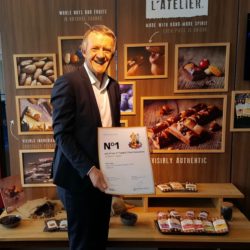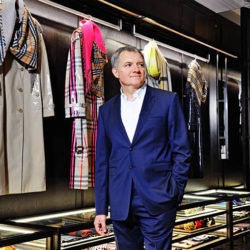Chris Tyas, Nestlé: “Soon we can expect more CEOs to come from supply chain”

Supply Chain Management is dead, according to a recent report by Harvard Business Review. But before everyone starts polishing up his or her CV, it’s anything but, retorts Chris Tyas, Senior Vice President Supply Chain, of Nestlé. With 41 years in the business he has witnessed phenomenal change and doesn’t believe that, even in today’s digitalised global end-to-end supply chain, technological innovation can replace the human element. “Technology certainly alleviates the day-to-day hard slog, but its key asset is that it frees up supply chain people to make the next step forward. And there is still a long way to go.” He says that the era of supply chain, when more CEOs will emerge from operations, is just beginning!
Interview conducted by Martijn Lofvers and Edwin Tuyn, written by Helen Armstrong
We met Chris Tyas at Nestlé Headquarters in Vevey, Switzerland, when he was also presented with the award for No 1 Supply Chain Executive DACH (Germany, Austria and Switzerland) in recognition of his business success and contribution to the sector. As head of global supply chain for the world’s largest food and beveragecompany he has made a career of expecting the unexpected. He joined Nestlé in the UK in 1982 when barcodes were emerging and his first computer was an Acorn. Now, on the verge of his retirement, he can look back on how technology has improved communication, reduced error, cut costs, built processes and helps to sell more than 1 billion Nestlé products daily.
Yet, as supply chain embarks on a new era and plays an extended role in the business, more than ever supply chain executives need good communication skills, sound judgement, perseverance and creativity. He says that the need to reach out across the entire supply chain, to create shared value for all partners, is the key to supply chain in future.
Supply Chain Management is not dead! Having being part of it for the last four decades how do you see it developing in future?
“It is anything but dead! The Harvard Business Review article, which predicts the death of supply chain management, is an interesting thought pattern, but in my opinion it draws the wrong conclusion. It suggests that technology, such as AI and cognitive thinking, will remove the importance of Supply Chain Management. Technology does allow day-to-day tasks to be automated and reduces costs, but technology in itself does not innovate and therefore does not take us forward. It just optimises the situation that we have today. However, technology does release supply chain management to do the value added tasks, which require interpersonal skills. This is what will take us forward.
I am hugely optimistic and believe there is huge opportunity for supply chain managers, firstly to optimise the end-to-end supply chain and secondly to optimise logistics as a whole. In general, we still make appalling use of vehicles, both inbound and outbound. Very few inbound vehicles are optimised for weight and cube and it becomes even worse when we go forward towards the consumer. How many different vans from different retailers deliver to different, or sometimes even the same customers in any one street? If we are going to keep logistics operating efficiently this has to change.
Also various articles have described the huge shortage of drivers in the USA and it is no longer just a matter of cost, it is actually limiting economic growth. And it will get worse: The average age of driver in the USA is 57, added to which is the recent legislation that controls drivers’ hours. Many parts of Europe face similar problems. How many drivers want to drive the length and breadth of Europe or the USA when instead, with the rise of ecommerce, they can drive for local suppliers and be home every night?
It’s a similar story for inbound. We need to use technology to optimise this, for example self-driving trucks or follow-me trucks that are currently being tested for picking in DCs. These can save a lot of time in high pick environments because a driver doesn’t have to get on and off the truck each time. I still see huge opportunities for supply chain management!”
But the new technology and data available today does put new demands on supply chain managers compared with 20 years ago?
“Yes, it forces supply chain professionals to be outward-looking and be more collaborative in their approach. This is critically different to 20 years ago. However, we still see that supply chain professionals focus internally, mainly on cost rather than the overall profit. Often people have come from operational research type backgrounds and still specialise in one aspect, optimising what they can control. But we need people to focus externally and reach out across the entire value chain in order to optimise it from end-to-end. This can only be done in partnership and I believe this is where the big opportunity lies.
We are already going through change. If you go back through the generations you see that most CEOs in the late 19th to early 20th century were manufacturers, eg Henry Ford. The 1950s saw the start of mass consumer marketing and many CEOs were marketers. Then in 1980s and 90s investors expected more and finance people were promoted to CEO. As we move from a value chain to a network – the way supply chain is expected to go – then the Tim Cook’s of this world will become the norm. We are moving into a new era in which we can expect more CEOs to come from supply chain.”
How do you get people to change their outlook and reach out across the value chain?
“I believe it is about leadership and painting the bigger picture. If you make a presentation and only talk about internal numbers, rather than the end-to end value chain, then you don’t set a good example. The CEO sees value when the supply chain executive takes an external perspective and opens up people’s eyes. We run a course for our most senior supply chain managers about how to change from leading a function within a function to leading a function within the business.
It can be very hard to move from reporting to another supply chain professional to reporting to a CEO: You have to change language. We invite CEOs to come along and tell us what they believe makes a good supply chain person. They say it’s those that show willingness to embrace an external perspective, for example the customer: They are not just optimising what is within their control. Instead they reach out in order to understand how the processes work in the other parts of the value chain. When I began in procurement my boss said that to be a good buyer you have to understand your vendors’ manufacturing processes better than they do themselves: Ultimately it is reverse engineering and this is what allows you to see opportunities.” … … …
Want to read more?
Subscribe on iPad or Android tablet to read the full version >>
or
Subscribe on print to receive the next issue >>
This article was first published in Supply Chain Movement 30 | Q3 – 2018









